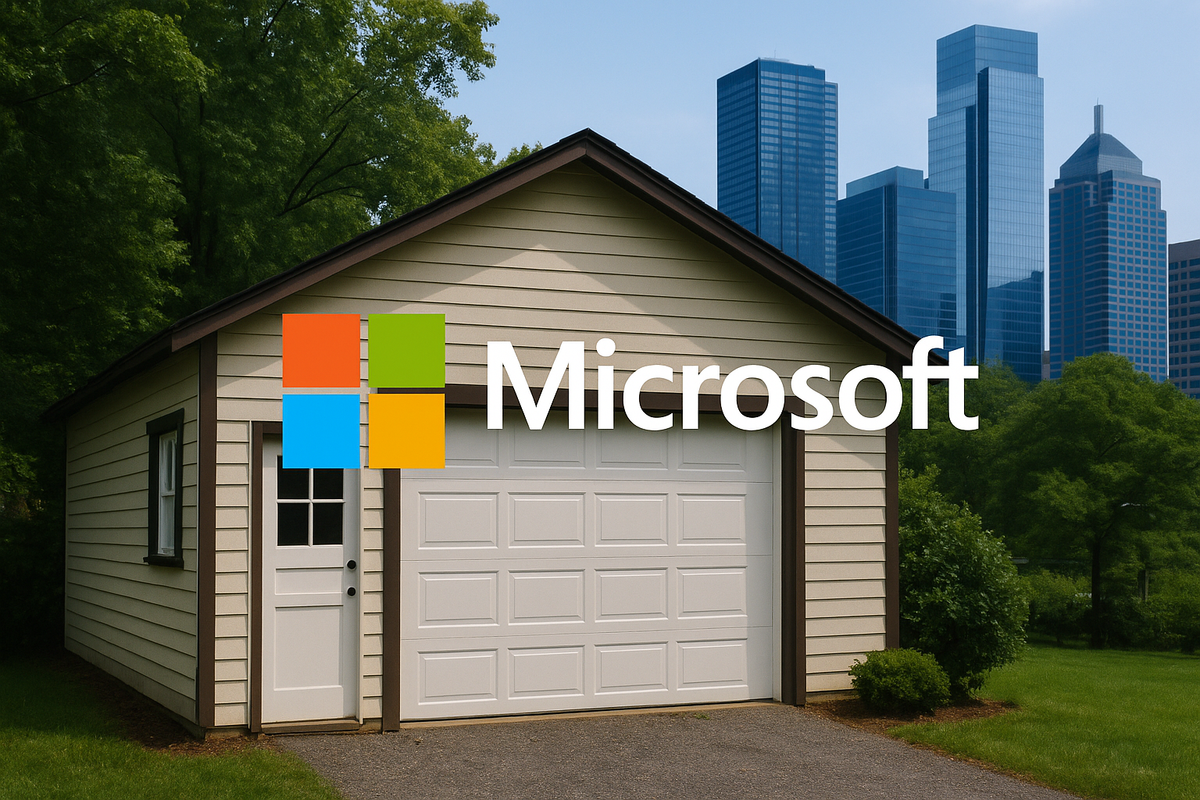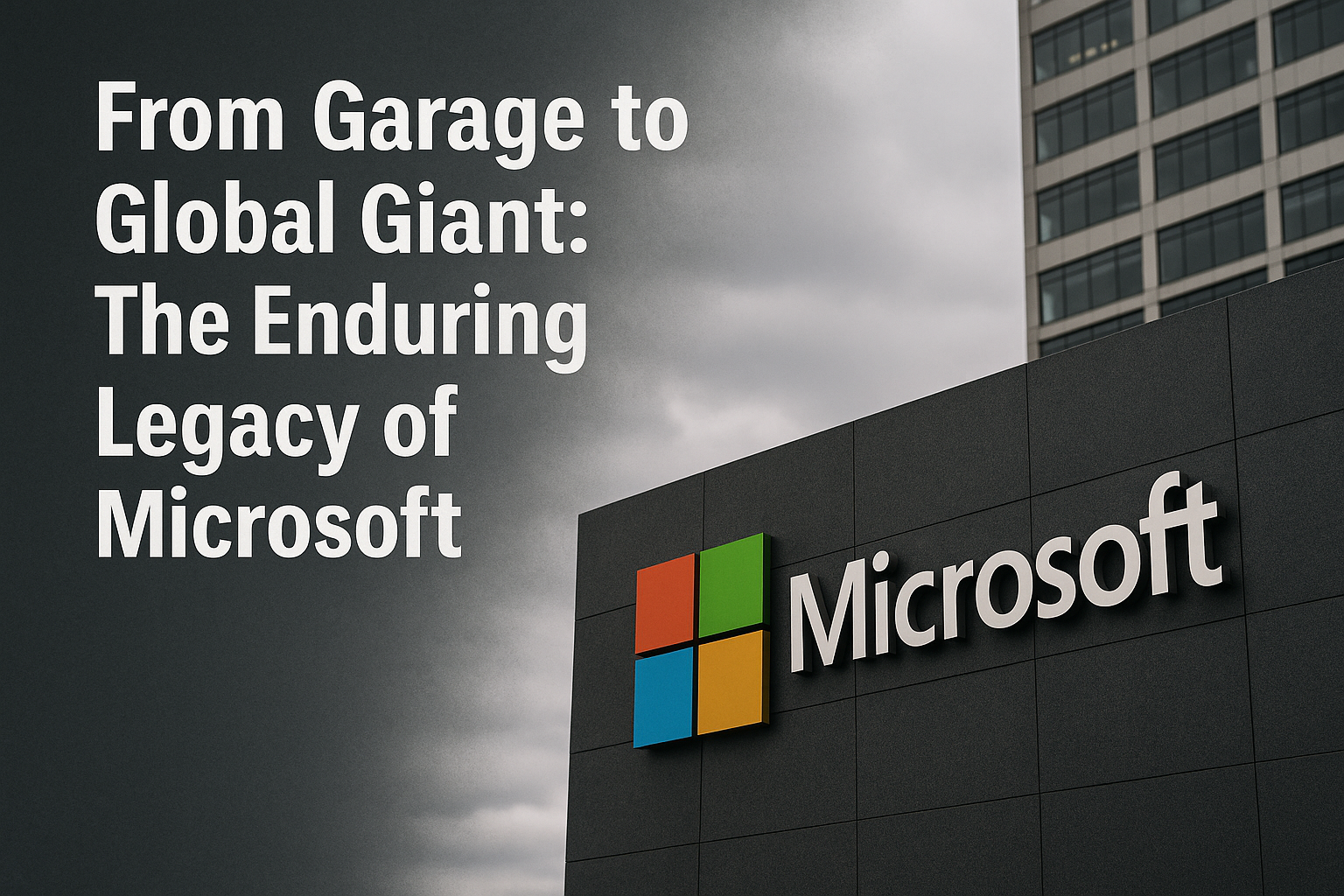From Garage to Global Giant: The Enduring Legacy of Microsoft


Microsoft (NASDAQ: MSFT) stands as a titan of the technology world, a company whose innovations have profoundly shaped the digital landscape and permeated nearly every aspect of modern life. From its humble beginnings developing programming languages to its current status as a diversified technology conglomerate, Microsoft has consistently been at the forefront of computing, driving advancements in operating systems, software applications, cloud services, and hardware. Its journey is a testament to relentless innovation, strategic adaptation, and a vision that has consistently aimed to empower individuals and organizations through technology.
Foundation and Early Years
Founding Story
The story of Microsoft begins in 1975 with two childhood friends, Bill Gates and Paul Allen. Inspired by the January 1975 issue of Popular Electronics featuring the Altair 8800, the first microcomputer, they immediately recognized the immense potential of developing software for this nascent technology. Gates and Allen, despite not having a working interpreter, boldly contacted Micro Instrumentation and Telemetry Systems (MITS), the creators of the Altair 8800, claiming they had a BASIC interpreter ready. Their successful demonstration in March 1975 led to a deal with MITS to distribute their Altair BASIC. Following this, Allen moved to Albuquerque, and Gates famously dropped out of Harvard to join him. They officially co-founded Microsoft on April 4, 1975, in Albuquerque, New Mexico, with Bill Gates as CEO. The name "Micro-Soft," a portmanteau of "microcomputer" and "software," was suggested by Paul Allen and later registered as "Microsoft" on November 26, 1976.
Initial Business Model
Microsoft's initial business model centered on developing and selling BASIC interpreters for microcomputers. Their goal was to make personal computers more accessible by providing user-friendly programming languages. The pivotal moment for their business model arrived in 1980 with a partnership with IBM. IBM was seeking an operating system for its first personal computer, the IBM PC. Microsoft strategically acquired an existing operating system from Seattle Computer Products, adapted it, and rebranded it as MS-DOS (Microsoft Disk Operating System). This deal was revolutionary: IBM paid Microsoft a royalty for every IBM PC sold with MS-DOS, but crucially, Microsoft retained the rights to license MS-DOS to other computer manufacturers. This licensing model, where Microsoft provided software to be pre-installed on hardware from various manufacturers, became the bedrock of their early success, allowing them to dominate the burgeoning PC market.
Early Challenges and Solutions
Microsoft faced several significant challenges in its early years, typical of a rapidly evolving industry:
- Recruiting Talent: Initially, attracting top programmers to Albuquerque, New Mexico, proved difficult.
- Solution: Microsoft addressed this by relocating its headquarters to Bellevue, Washington, in January 1979, a move that significantly improved their ability to recruit skilled professionals.
- Establishing Dominance in a Fragmented Market: The early computer market was fragmented, with various manufacturers using different operating systems, making it easy for users to switch.
- Solution: The strategic partnership with IBM for MS-DOS was a game-changer. By retaining licensing rights, Microsoft established MS-DOS as a de facto industry standard, creating a powerful network effect where more users led to more software development, further solidifying its position.
- Competition and User Interface Evolution: As the PC market matured, companies like Apple focused on hardware with proprietary software and user-friendly Graphical User Interfaces (GUIs), posing a competitive threat.
- Solution: Microsoft recognized the future lay in GUIs. In 1985, they released the first version of Microsoft Windows as an add-on to MS-DOS. While early versions had limited success, Windows 3.0, launched in 1990, was a turning point, offering a more user-friendly GUI and multitasking capabilities. Microsoft's strategy of pre-installing Windows with PC manufacturers further cemented its market share.
- Software Compatibility and Integration: As Microsoft's product portfolio expanded, ensuring compatibility across different versions of their own products and with third-party systems became a continuous challenge.
- Solution: Microsoft developed tools like the Compatibility Toolkit and emphasized rigorous testing across various Windows versions and hardware configurations. They also provided tools and frameworks to help developers integrate their applications with third-party systems.
- Performance Optimization: Ensuring applications were responsive and scalable was another hurdle.
- Solution: Microsoft provided performance profiling tools to help developers identify bottlenecks and optimize their code for better speed and efficiency.
Growth and Development
Key Milestones
Microsoft's history is punctuated by a series of transformative milestones that propelled it from a startup to a global technology leader:
- 1975: Microsoft is founded by Bill Gates and Paul Allen, with their first product being a BASIC interpreter for the Altair 8800.
- 1980: A pivotal partnership with IBM leads to Microsoft providing the MS-DOS operating system for the IBM Personal Computer, establishing a crucial industry standard.
- 1985: Microsoft releases Windows 1.0, a graphical extension for MS-DOS, signaling a strategic shift towards graphical user interfaces.
- 1986: Microsoft goes public with an initial public offering (IPO), a significant event that created numerous millionaires among its employees. The company also moves its corporate campus to Redmond, Washington.
- 1989: The earliest version of the Microsoft Office suite, including Word, Excel, and PowerPoint, is introduced, revolutionizing productivity software.
- 1995: The launch of Windows 95, with its iconic Start menu and taskbar, fundamentally changed the PC market. Microsoft also enters the web browser market with Internet Explorer.
- 2001: Microsoft diversifies into the gaming console market with the debut of the Xbox.
- 2008: Microsoft launches the Azure Services Platform, marking its significant entry into cloud computing.
- 2012: Microsoft introduces its own line of hardware with the Surface tablets, blending software and hardware innovation.
- 2016: Microsoft acquires LinkedIn, expanding its reach into professional networking.
- 2018: Microsoft acquires GitHub, further solidifying its focus on cloud and AI technologies.
- 2019: Microsoft briefly achieves a market capitalization of over $1 trillion.
- 2020: Office 365 is rebranded as Microsoft 365, reflecting its evolution into a comprehensive suite of cloud-based productivity, communication, and security tools.
- 2022: Microsoft announces plans to acquire Activision Blizzard, a move aimed at strengthening its gaming portfolio.
Market Expansion
Microsoft's market expansion has been a multi-faceted strategy, encompassing product diversification, market penetration, market development, and strategic acquisitions:
- Product Diversification: Beyond its initial focus on software, Microsoft has ventured into entirely new markets. The Xbox, for instance, marked its successful entry into the gaming industry. Other examples include enterprise services, the rapidly growing cloud computing sector with Azure, and hardware with its Surface devices.
- Market Penetration: A core growth strategy has been to intensify marketing and sales efforts to capture a larger share of existing markets for its established products.
- Market Development: Microsoft has actively sought to enter new geographical markets and target new customer segments. An example is the modification of Windows 95 specifically for the Japanese gaming market, which allowed them to capture a significant share.
- Strategic Acquisitions: Acquisitions have played a crucial role in Microsoft's growth. By acquiring complementary platforms and services, such as LinkedIn and GitHub, Microsoft has enhanced its product offerings, expanded its user base, and strengthened its market position.
- Partnerships: Early partnerships, like the one with IBM, were instrumental in establishing industry standards and propelling Microsoft's software to the forefront. Microsoft also collaborates with other major companies like Adobe and SAP to broaden its offerings and customer reach.
- Global Presence: Microsoft demonstrated an early commitment to global reach, establishing its first international office in Japan in 1977 and an international production facility in Ireland in 1985.
Product/Service Evolution
Microsoft's product and service evolution reflects its remarkable adaptability and continuous innovation across various technological shifts:
- Operating Systems:
- MS-DOS: Microsoft's initial dominance in personal computer operating systems began with MS-DOS in the mid-1980s.
- Windows: The launch of Windows 1.0 in 1985 marked a pivotal shift to a graphical user interface. Subsequent versions like Windows 3.0 (1990) and Windows 95 (1995) significantly improved performance and user-friendliness, solidifying Windows' market supremacy, capturing over 90% of the world's personal computer market share by the late 1990s. The evolution continued with Windows XP, Vista, Windows 7, Windows 8, Windows 10, and Windows 11, each iteration bringing new features and improvements.
- Productivity Software:
- Microsoft Office: Introduced in 1989, the Office suite (Word, Excel, PowerPoint) became an indispensable tool for businesses, education, and personal use.
- Microsoft 365: The transition from Office 365 (launched 2011) to Microsoft 365 (rebranded 2020) exemplifies Microsoft's shift towards cloud-based software, offering a comprehensive suite of productivity, communication, and security tools as a subscription service.
- Internet and Web Services:
- Internet Explorer: Microsoft entered the internet arena with Internet Explorer in the mid-1990s, which for a time became the dominant web browser.
- MSN: Microsoft also ventured into online services with the Microsoft Network (MSN).
- Gaming:
- Xbox: Microsoft's foray into gaming began with the Xbox console in 2001, followed by successful iterations like the Xbox 360, establishing a strong presence in the console market.
- Cloud Computing:
- Microsoft Azure: Launched in 2008, Azure has become a cornerstone of Microsoft's business, a rapidly growing cloud services platform that is a major revenue driver for the company.
- Hardware:
- Surface Devices: In 2012, Microsoft launched its own line of hybrid tablet computers, the Surface series, showcasing its commitment to blending hardware and software innovation.
- Artificial Intelligence (AI):
- Microsoft has made substantial investments in AI, integrating AI technology into its products and services, including Azure AI and advancements with Cortana. The company's backing of OpenAI has also led to the development of cutting-edge AI tools like GitHub Copilot.
- Other Products and Services: Microsoft's diverse portfolio also includes email services (Outlook.com), search engines (Bing), and a wide array of enterprise services.
Major Achievements
Industry Innovations
Microsoft has consistently been a pioneer in the technology industry, driving numerous innovations that have shaped the digital world:
- Operating Systems and Productivity Software: Microsoft's early innovations with MS-DOS and the revolutionary Windows operating system fundamentally changed personal and business computing. The introduction of the Microsoft Office suite (now Microsoft 365), including Word, Excel, and PowerPoint, set the standard for productivity software. Their commitment to user-friendly graphical interfaces and pre-installed software made computing accessible to a wider audience.
- Cloud Computing (Azure): Launched in 2010, Microsoft Azure has become a cornerstone of Microsoft's strategy, offering a comprehensive cloud platform with over 200 services, including AI, machine learning, IoT, and analytics. Azure supports diverse applications, from real-time data insights to predictive maintenance. Microsoft's development of custom-designed chips like the Azure Maia AI Accelerator and Azure Cobalt CPU further optimizes AI and general-purpose workloads in the cloud, enhancing performance and efficiency.
- Artificial Intelligence (AI): Microsoft has emerged as a global leader in AI, deeply integrating AI across its ecosystem through its partnership with OpenAI and continuous innovation in its own AI tools. Key AI innovations include:
- Azure AI: A robust cloud platform providing services and tools for building, training, and deploying AI models, supporting applications from natural language processing to machine learning.
- Microsoft Copilot: Integrated into Microsoft 365 applications, Copilot leverages AI to automate tasks, provide intelligent suggestions, and significantly enhance user productivity. Microsoft also offers AI Studio and Copilot Studio to simplify AI application development.
- Strategic Partnerships: Microsoft's AI success is bolstered by strategic collaborations with industry leaders like OpenAI, Accenture, and NVIDIA, expanding its capabilities and offering advanced tools to customers.
- Productivity Tools (Microsoft 365 and Dynamics 365): Microsoft 365 (formerly Office 365) combines essential productivity tools with advanced cloud services and security, making it indispensable for modern workplaces. Dynamics 365 integrates CRM and ERP capabilities, enabling organizations to streamline operations and deliver exceptional customer experiences.
- Gaming (Xbox): Microsoft's entry into the gaming industry with the Xbox console has been a significant innovation, leading to the establishment of Microsoft Gaming in 2022. The company has heavily invested in expanding its Game Pass library and launched Xbox Cloud Gaming, further pushing the boundaries of interactive entertainment.
Awards and Recognition
Microsoft has garnered numerous awards and widespread recognition for its corporate culture, leadership, and technological advancements:
- Company Culture and Leadership: Microsoft has consistently been recognized for its strong company culture and leadership. In 2024, it received awards for "Best CEOs," "Best Company Perks & Benefits," and "Best Global Culture." In 2023, it was honored with "Best Company Compensation," "Best CEOs for Diversity," "Best Leadership Teams," "Best Company Outlook," "Best Engineering Teams," and "Best Global Culture." Frost & Sullivan also awarded Microsoft the "2023 Global Company of the Year Award" in the connected work industry for its innovative communication platform and AI-driven workforce collaboration tools.
- Corporate Social Responsibility (CSR) and ESG: Microsoft is a recognized leader in corporate social responsibility and environmental, social, and governance (ESG) performance. It was included in the 2023 "100 Best Corporate Citizens list" by 3BL and received an AAA rating from MSCI Ratings, the highest available. Sustainalytics recognized Microsoft as a top ESG performer in 2023, and it was ranked among the top 100 companies globally with the best corporate reputations by Global RepTrak® 100. In 2024, Microsoft remained a leader in the JUST 100 rankings, placing fifth in its industry, and received top scores in all three Environment, Social, and Governance pillars by ISS Environmental and Social QualityScore in 2023.
- Scientific Contributions: The Royal Society and Académie des sciences Microsoft Award, sponsored by Microsoft Research, was an annual award from 2006 to 2009, recognizing scientists in Europe who made significant contributions to science through computational methods.
- Partner Recognition: Microsoft also acknowledges the outstanding successes and innovations of its partners through the Microsoft Partner of the Year Awards, spanning over 100 countries and various categories.
Market Leadership Positions
Microsoft holds dominant market leadership positions across several critical technology sectors:
- Operating Systems (Windows): Windows remains the most popular desktop operating system globally, holding a significant market share. As of March 2023, it commanded a 70% market share, and as of July 2025, Windows 11 is the most commonly installed desktop version of Windows, with a market share of 52.0%. While Android leads in overall operating systems (including mobile), Windows maintains its strong position in the desktop segment.
- Cloud Computing (Azure): Microsoft Azure is the second-largest cloud service globally. In Q1 2024, Azure's market share reached 24% of the cloud computing market, and in Q1 2025, it captured nearly 25% of the global cloud market, demonstrating substantial growth in its customer base.
- Productivity Software (Microsoft Office/Microsoft 365): Microsoft has been market-dominant in the office software suite market since the 1990s. While Google Workspace has a larger share by scope in some reports, Microsoft 365 held 30% of worldwide usage as of February 2024, and some reports indicate Microsoft continues to hold roughly 90% of the overall office suite market.
- Gaming (Xbox): As of 2023, Microsoft holds a 27.3% market share in the console gaming market (hardware, content, and subscriptions). In the high-end console market, Microsoft has a 30% market share compared to Sony's 70% as of 2023. However, in terms of console operating system market share, Xbox holds a significant lead, with 67.55% worldwide as of June 2025, and a commanding 74.41% share in the United States.
- Surface Devices: Microsoft Surface devices are widely adopted by large companies. While Microsoft's tablet market share is 11% compared to iPadOS (38%) and Android (49%) as of September 2023, Microsoft is actively challenging the entry-level market with new AI-powered Surface devices.
Corporate Culture and Leadership
Notable Leaders and Their Contributions
Microsoft's trajectory has been profoundly shaped by the vision and leadership of several key figures:
- Bill Gates (Co-founder, former CEO, and Chairman): As co-founder with Paul Allen in 1975, Bill Gates was the driving force behind Microsoft's early success. Serving as CEO for 25 years, he was instrumental in establishing Microsoft's dominance in software, particularly with the Windows operating system and the ubiquitous Office suite. Gates's foresight in setting clear technical boundaries, such as the Windows API, fostered an ecosystem that fueled unprecedented economic growth and the rise of countless businesses globally. He transitioned from chairman in 2014 and resigned from the board in 2020 to dedicate more time to philanthropic endeavors through the Bill & Melinda Gates Foundation.
- Paul Allen (Co-founder): Co-founded Microsoft with Bill Gates in 1975. Allen's early contributions were crucial in the company's formative years, though he departed in 1983 due to health reasons.
- Steve Ballmer (Former CEO): Succeeding Bill Gates as CEO in 2000, Steve Ballmer is credited with democratizing computing, expanding access to technology for individuals and businesses of all sizes. He oversaw the continued growth of key products like Office 365 and Azure, shifting IT to a central driver of business. While his tenure (2000-2014) saw significant expansion, it also faced criticism regarding a perceived lack of innovation in certain areas.
- Satya Nadella (Current Chairman and CEO): Appointed CEO in 2014, Satya Nadella has been widely lauded for his transformative leadership. He spearheaded a significant cultural shift at Microsoft, moving from a "know-it-all" to a "learn-it-all" mentality, fostering curiosity, openness, and a growth mindset. Under Nadella's guidance, Microsoft has achieved remarkable advancements in cloud computing (Azure), artificial intelligence, and digital transformation. His emphasis on empathy as a core leadership philosophy has reshaped the company's identity. Nadella's tenure has also included strategic acquisitions such as LinkedIn and Activision Blizzard.
- Brad Smith (Vice Chair and President): Joining Microsoft in 1993 and serving as president since 2015, Brad Smith is responsible for legal, corporate affairs, and social responsibility initiatives. He is known for his conciliatory approach in antitrust cases and his engagement with regulators.
- Mustafa Suleyman (CEO of Microsoft AI): One of Microsoft's newest senior management team members, Mustafa Suleyman joined in March 2024 to lead consumer AI efforts through the newly formed Microsoft AI unit, signaling Microsoft's continued commitment to leadership in artificial intelligence.
Company Values and Mission
Microsoft's mission and values are fundamental to its identity and guide its operations:
- Mission Statement: "To empower every person and every organization on the planet to achieve more." This mission underscores Microsoft's dedication to leveraging technology to empower individuals and organizations globally, enabling them to realize their full potential. It emphasizes inclusivity and providing tools and resources for personal growth, learning, creativity, productivity, and innovation.
- Vision Statement: "To democratize AI, making it accessible and beneficial for everyone." This vision highlights Microsoft's aspirations to drive innovation, inclusivity, and accessibility, positioning it as a leader in the evolving technology industry, particularly in the realm of artificial intelligence.
- Corporate Values: Microsoft's values are deeply aligned with its mission and underpin its corporate culture, influencing how employees interact with each other, customers, and partners. Key values include:
- Innovation: A belief that technology can be a force for good and that meaningful innovation contributes to a brighter world.
- Diversity & Inclusion: A commitment to embracing diverse voices and perspectives, engaging with the experiences, strengths, and different viewpoints of employees and customers to inform and challenge thinking.
- Accountability: Employees taking ownership of their actions and outcomes, striving to deliver value to customers and stakeholders.
- Quality and Innovation: A relentless pursuit of excellence in products and services and a continuous search for new ways to improve them.
- Responsiveness to Customers: A dedication to actively listening to customer needs and feedback and aiming to exceed expectations.
- Growth Mindset: A significant cultural shift under Satya Nadella, encouraging continuous learning and development, and embracing challenges and changes as opportunities.
- Respect and Integrity: These values form the bedrock of Microsoft's operations, fostering a positive work environment and upholding ethical practices.
- Corporate Social Responsibility: A belief that technology is a powerful force for good, coupled with a commitment to fostering a sustainable future where everyone has access to the benefits and opportunities created by technology.
- Trustworthy Computing: A long-standing value emphasizing security, privacy, and reliability in its products and services.
Organizational Philosophy
Microsoft's organizational philosophy has undergone a significant evolution, particularly under Satya Nadella's leadership, to cultivate a more collaborative and adaptive environment:
- Culture of Accountability, Quality, and Innovation: These core principles define Microsoft's culture, guiding employee behavior and decision-making across the organization.
- Growth Mindset: A pivotal shift from a "know-it-all" to a "learn-it-all" culture, fostering continuous learning, development, and a willingness to embrace challenges and changes as opportunities for growth.
- Diversity and Inclusion: A strong commitment to building diverse workforces and strengthening a culture of inclusion, recognizing that diverse perspectives drive innovation.
- Customer Focus: A deep-seated commitment to creating solutions that genuinely meet customer needs and empower every individual and organization to achieve their business goals.
- "One Microsoft" Approach: This strategic approach, introduced to foster collaboration, alignment, and synergy across the company, aims to break down internal silos and create a unified, cohesive organization. It emphasizes cross-team collaboration, knowledge sharing, and collective accountability to respond effectively to market demands.
- Agility and Collaboration: Microsoft's organizational structure is designed to emphasize these traits, enabling rapid innovation while maintaining alignment with strategic goals.
- Empathy in Leadership: Under Satya Nadella, empathy has become a cornerstone of Microsoft's culture, shaping how leaders connect with employees, customers, and partners. This human-centered leadership approach views employees as individuals with emotions and aspirations, fostering a more compassionate work environment where inclusion and psychological safety thrive.
- Employee Development: Microsoft invests heavily in training programs and resources to help employees develop new skills and stay ahead in the rapidly changing world of technology, ensuring a highly skilled and adaptable workforce.
Current Status
Current Market Position
As of July 2025, Microsoft (NASDAQ: MSFT) stands as the world's second most valuable company, boasting a market capitalization of $3.84 trillion. Its strong market position is underpinned by its strategic focus on cloud computing, artificial intelligence (AI), and gaming.
- Cloud Computing (Azure): Microsoft Azure is a dominant force in the cloud infrastructure market, holding the second-largest global market share. In Q4 2024, Azure commanded a 21% market share, trailing Amazon Web Services (AWS) at 30% but ahead of Google Cloud at 12%. Other reports indicate Azure's market share at 24% as of Q3 2024 and 25% in Q2 and Q1 2024. Azure's revenue growth has been robust, with a 31% year-over-year increase in Q1 2024 and 28% in Q2 2024, with AI services significantly contributing to this expansion.
- Operating Systems (Windows): Windows continues to be the leading desktop operating system worldwide, holding a 70.14% market share as of June 2025. Within the Windows ecosystem, Windows 10 held a 62.79% market share at the end of September 2024, while Windows 11 accounted for 33.37%. Windows 11 experienced a notable increase in market share in 2024, driven by the impending end of support for Windows 10 and the introduction of Copilot+ PCs.
- Productivity Software (Microsoft 365): Microsoft Office 365 is a major player in the global market for office productivity software. As of 2022, it held a 45.46% market share, making it the second most popular office productivity software. In Q2 2024, Microsoft 365, alongside Google Workspace and Gmail, remained a dominant force in the business and productivity software arena. Microsoft Office 365 holds a 22.39% market share in the broader productivity market, and its share in the U.S. government office productivity software market is approximately 85%.
- Gaming (Xbox): Following the acquisition of Activision Blizzard King in October 2023, Microsoft became the third-largest gaming company globally by revenue. As of 2023, Microsoft held a 27.3% market share in the console gaming market, behind Sony (45%) and Nintendo (27.7%). In December 2024, Microsoft was the top games publisher across PlayStation, Xbox, and Steam platforms, largely due to the success of Call of Duty: Black Ops 6. Microsoft Gaming is also the third-biggest mobile game developer worldwide in terms of revenue.
Recent Developments
Microsoft has been actively pursuing strategic initiatives and has reported strong financial results:
- Q3 2024 Earnings: Microsoft reported robust Q3 2024 earnings, surpassing analyst expectations. Revenue reached $61.9 billion, a 17% increase year-over-year, and net income rose to $21.9 billion, up 20% from the previous year. The Intelligent Cloud segment, which includes Azure, was a significant contributor, generating $26.7 billion in revenue, a 20.9% increase year-over-year. Productivity and Business Processes contributed 31.64% of total revenue, while More Personal Computing accounted for 25.19%.
- Acquisitions: Microsoft has continued its strategy of strategic acquisitions to expand its capabilities and market reach.
- Activision Blizzard King (October 2023): This $68.7 billion acquisition was Microsoft's largest ever and significantly bolstered its position in the gaming industry, adding popular franchises like Call of Duty, World of Warcraft, and Candy Crush.
- Inflection AI (March 2024): This acquisition aims to integrate AI into everyday applications, strengthening Microsoft's position in conversational AI and supporting platforms like Microsoft 365, Azure AI, and OpenAI's ChatGPT.
- AI Integration and Investment: Microsoft is heavily investing in AI, integrating AI capabilities across its product suite.
- The company plans to increase its data center investment to $80 billion in 2025, a 44% increase from 2024, primarily for AI training and cloud-based applications. Over half of this investment will be directed to US-based projects.
- Microsoft is focusing on "AI design wins" with every customer and promoting the adoption of Copilot. Copilot is projected to generate $25 billion in revenue by FY26.
- Microsoft is boosting partner funding for Copilot offerings by 50% and Azure outcome-based incentives by 70% for its fiscal year 2026.
- Workforce Adjustments: Microsoft cut approximately 1,900 employees from its gaming division at the beginning of 2024, including staff from the recently acquired Activision Blizzard.
Future Outlook
Microsoft appears well-positioned for continued success, with a clear strategic focus on high-growth areas:
- AI Transformation: AI is central to Microsoft's future strategy. The company aims to deeply incorporate AI capabilities into its products, including Microsoft 365, cloud services, and new AI-driven solutions. Microsoft is focused on empowering every person and organization to achieve more through AI and is committed to responsible and trustworthy AI development.
- Cloud Expansion: Microsoft will continue prioritizing the global expansion of its Azure cloud platform, investing in new data centers and innovative cloud solutions to gain market share. Azure's growth is expected to be between 34-35% in Q2 2025, with AI services being a key contributor.
- Gaming Innovation: Following the Activision Blizzard acquisition, Microsoft will focus on leveraging this asset to drive innovation and growth in its gaming segment, including developing new gaming experiences, expanding Xbox Game Pass, and exploring cloud gaming and the metaverse.
- Strategic Priorities for FY25: Microsoft's strategic focus for fiscal year 2025 includes AI integration, cloud expansion, and gaming innovation. The company is also emphasizing security and quality as "non-negotiable" priorities.
- Financial Projections: For the full year ending June 2024, earnings are projected to rise 17% year-over-year to $11.64 per share, with revenue of $244.22 billion, a 15.2% increase. Analysts expect Microsoft to continue its strong financial performance, with revenue growth driven by Azure public cloud adoption, Office 365 upselling, and AI adoption. Microsoft is expected to generate $13 billion in AI revenue by 2025, with Azure AI services growing at 175% year-over-year.
- Acquisition Strategy: Microsoft is expected to pursue further acquisitions in FY25, potentially focusing on cybersecurity and communication, aligning with its strategy of offering comprehensive solutions.
Summary
Microsoft's journey from a small startup developing programming languages to a global technology powerhouse is a compelling narrative of innovation, strategic foresight, and adaptability. Founded by Bill Gates and Paul Allen in 1975, the company's early success was built on its pioneering MS-DOS operating system and the subsequent widespread adoption of Windows, which revolutionized personal computing. This foundation was further solidified by the introduction of the ubiquitous Office suite, establishing Microsoft as a leader in productivity software.
Under the transformative leadership of Satya Nadella, Microsoft has successfully navigated shifts in the technology landscape, embracing cloud computing with Azure and emerging as a frontrunner in artificial intelligence. The company's commitment to a "learn-it-all" culture, coupled with strategic acquisitions like LinkedIn and Activision Blizzard, has diversified its portfolio and strengthened its market position across various sectors, including gaming and enterprise solutions. With a clear focus on AI transformation, continued cloud expansion, and gaming innovation, Microsoft is poised for sustained growth, continuing its mission to empower individuals and organizations worldwide to achieve more.



